
Swastika signs on american advertisements and banners
Swastika, a good luck symbol was commonly used as company logo, names of organization, firms and companies, and trademark in the continent of North America. Once a state symbol, swastika appeared on all state ancient flags and highway signs.In this article, we will explore the ancient use of swastika signs on various advertisements and banners of Unites states of America.
Swastika banner at Arizona state highways and roads
Sacred symbol swastika was venerated all over Arizona. Like a Talisman, Swastika was used to signify the location of Native American selling shops and trading spots. Since it was considered as a lucky symbol for the travelers set on a journey, swastika symbol was usually found on roads, highways, railway stations, airports etc. Sadly, today it is very hard to find such swastika on American public places courtesy of the holocaust done by the Nazi empire.
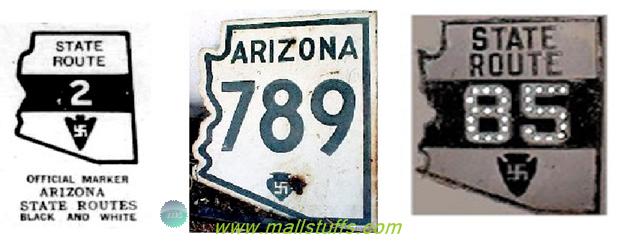
Swastika symbol on state highways and roads
Instead of names, highways or roads were recognized by a number as shown in the image above. Arizona adopted the border of its state and a swastika symbol on road signs & banners like the one shown above.
Swastika Advertisement of El Tovar hotel of Grand Canyon
El Tovar hotel was founded by Fred Harvey. Almost all institutions set up by Harvey were adorned with Native American arts and swastika symbol, most of them for sale. When this hotel was established, swastika was widely regarded as the symbol of luck and fortune. Hitler use of swastika in WWII made swastika the symbol of evil and oppression. Even today, hotel El Tovar has retained its original elegance and beauty. This hotel offers a breathtaking view of the Grand Canyon plus many ancient spoons with embossed swastika can be purchased as a souvenir item.
Dated 1908, below is an advertisement of El Tovar hotel of Grand Canyon on a Navajo blanket with sacred swastika and Greek Christianity cross.
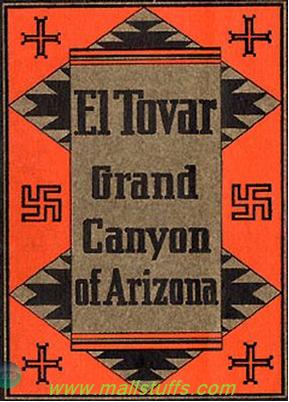
Advertisement of El Tovar hotel with swastika symbol
Swastika Advertisement of El Tovar hotel of Grand Canyon
Travelling across the hot deserts of Arizona where the splattering hot mud sticks to your body, dust clouds linger on the face, tourists especially ladies always looks for a good hotel or rest rooms to fresh up their mind and body. For such tourists were the ladies Rest Rooms of peach strings, Arizona which welcomed its visitors with the swastika sign. This rest room was a paradise for tourists looking for shower and rest after their adventurous journey in the hot Arizona desert
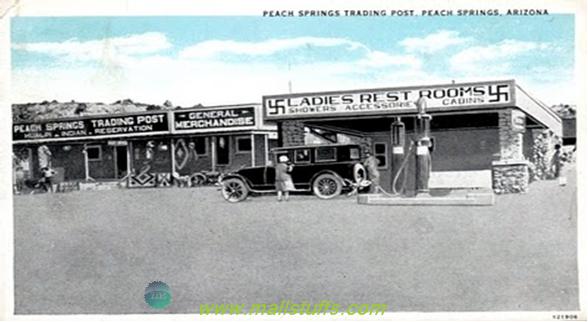
Advertisement published by D.T. Mallonee in 1928.
Swastika Advertisement of Indian shoe company
Slippers with swastika symbol were manufactured by the Indian shoe company founded by Benjamin Boyce in 1910. Handing over the company to few men’s and dozens of women’s, He later moved on to join the peninsular paper mill as the book keeper. Located at 17-21 Cross Street, above the present Fantasy Attic costume store, this was not the only Ypsi Company to use swastika. Many other Ypsi companies/Shops like Houghtalin, Clark and cooch company, WalkOver Shoe Company also branded their products with swastika symbol. Made in Ypsilanti swastika slippers were openly advertised in all leading magazines and newspapers including Cosmopolitan and Collier’s.
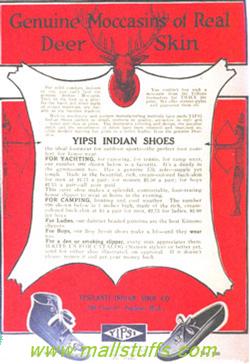
Advertisement of Indian Shoe Company
This company manufactured moccasins from scratch, with raw materials purchased from Ypsilanti Hide and Leather Company. According to locals, smell from this company was intolerable specially when there was a light breeze carrying away the smell to the far fledged area. Raw materials like animal skins and leather were cut and elaborately designed in shapes of swastika and Native American signs in sizes ranging from 2 to 7 for women and 3 to 10 for men. Ancient symbol and decorative symbols were used by this company to market its product among the hopi, navoja and other indigenous red Indians tribes who considered swastika as a sacred symbol. Company favorite motto used in their advertisements was “Guaranteed to wear and to satisfy for years, being INDIAN SEWED.”
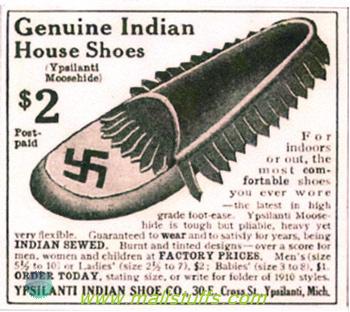
This is supposed to be an advertisement of the early 1920’s. 2$ for a shoe in the 1920 era sounds very costly to me.
1913 Advertisement in the Outing Magazine stated shoes manufactured by Indian Shoe Company as a perfect for a range of indoor and outdoor activities. After a decade, this and many other shoe company in the vicinity ran out of business and were closed permanently. This industrial area is today replaced by apartments leaving aside a few small shops and small scale industries. Leaving a few advertisements in vanished publication and unused city directories, Ypsilanti’s early 20th century original decorated shoes with hand-crafted moccasins has vanished from the pages of history.
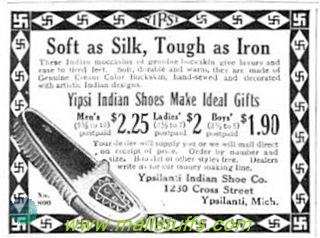
A 1912 advertisement in Cosmopolitan with the repeated swastika motif
Swastika Advertisement of General Roofing Manufacturing Company (currently Saint Gobain)
Based at PENNSYLVANIA, General Roofing Manufacturing Company was established by George M. Brown in 1904 with a startup capital of 25,000. During its foundation, company widely advertised its product with swastika with the belief that doing so would give a good startup for their company. In 1917, restructuring of the company led to its change in name as “Certainteed Products Corporation”. Starting from1918, this was among the first few companies to trade on New York stock exchange. Today, this company manufactures building material for both residential and commercial purpose and is a subsidiary of a France giant “Saint Gobain”. Today this company employs more than 10000 employees with revenues greater than 3 billion and products exported to more than 50 countries. With more than 350 patents in the last 30 years, it is one of the most innovative construction companies of this era.
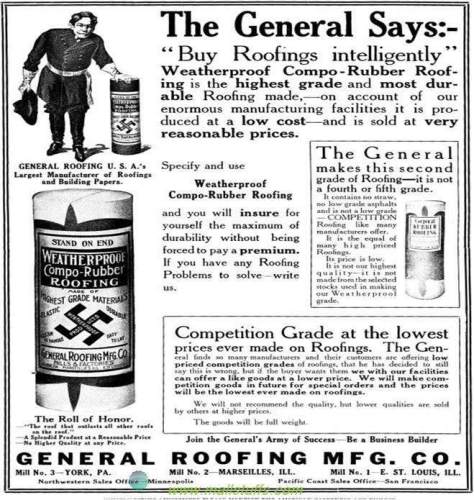
1914 advertisement of GENERAL ROOFING Manufacturing Company
Swastika Advertisement for sale of flats and furniture
Advertisement like the one shown below is very rare and precious. This advertisement is of the year 1911 from the American Carpenter and Builder’s magazine. This advertisement is regarding the sale of semi-furnished or fully-furnished flats. Found in the attic of old damaged house, this piece of paper is on sale in eBay for some hundreds of dollars.
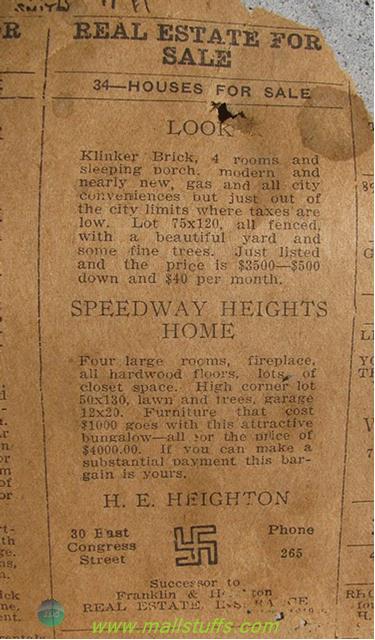
1911 advertisement for sale of flats and furniture
Swastika Advertisement of Wigwam villages
Wigwam villages, also known as wigwam motels, are a motel chain in United States. Rooms in these motels are constructed in ancient form of tips, locally called as wigwams, hence the name wigwam motels. Wigwam motels are established in seven different locations of America. They are
1) Cave city and horse cave at Kentucky county of Alabama state
2) Wigwam village at New Orleans, Louisiana
3) Wigwam village at Orlando, Florida
4) Wigwam village at Bessemer, Alabama
5) Wigwam village at Holbrook, Arizona
6) Wigwam village at San Bernardino , California
Advertisement of wigwam hotel as a popular tourist staying destination was carried on a large scale in leading newspaper and magazines of those times. Below is one of such advertisement where the wigwam villages is termed as the most unique tourist haven in America
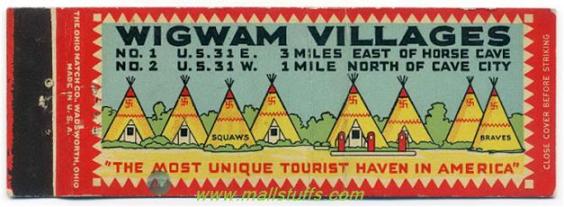
Advertisement of Wigwam villages
On December 17, 1935, Owner of Wigwam motel Frank A. Redford applied for a patent for the elaborate designs of its motel and was granted the same on February 18, 1936. These designs included a good luck charm symbol swastika of the time when it was considered as the symbol of auspiciousness and good luck.
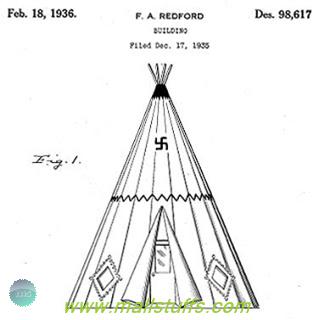
Patented design of wigwam motel with swastika symbol
Some of the wigwam villages are included in the National Register of Historic Places. Rooms of this motel consisted of a double bed, furniture, cable TV, air conditioner, small bathroom with sink, shower and toilet. These wigwam motels were usually situated near tourist destinations like Forest, National Park, and Meteor Crater.
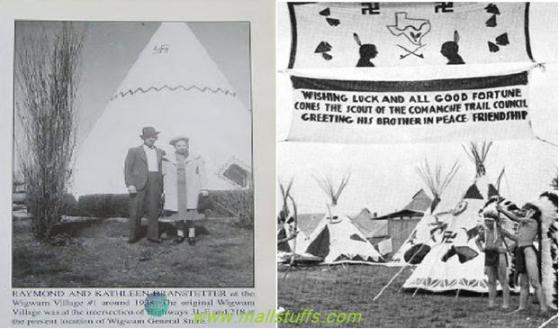
In the above image, you can see a couple posing in front of the wigwam village constructed in a patented swastika design while you can see some Native Americans wishing luck and god fortune to all the tourists.
Advertisement of Hotel Yucca (Swastika)
According to the article published in Raton daily range, construction of swastika hotel was proposed on Dec. 15, 1926 by a group of Texas businessman with the help of several Raton businessmen expressing their interest in partnership or business proposals. In the nearby rocky mountain, there was a big coal company called St. Louis Rocky Mountain Company which had a subsidiary named Swastika Fuel Company active in digging out the coal from the mountain. During the World War II, swastika emblem of this hotel became a liability since the tourist refereed the symbol as inauspicious, evil and hateful. Failing to explain their visitor’s about the rich historicity of swastika, Board of directors announced a contest to give a new name to this hotel. After going through thousands of entries, name Yucca (Mexiacan state flower) was chosen and the winner (Sixteen people who submitted the same name) was awarded the $25 prize. In 1971, this hotel was closed and the International State Bank opened its office in this building.
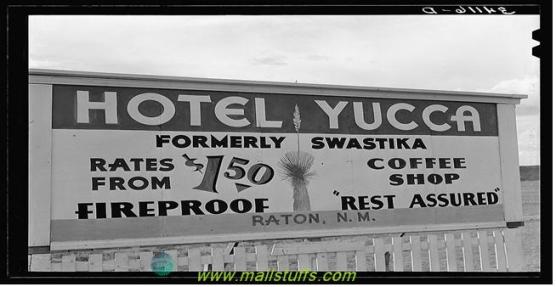
Banner depicting the change of swastika hotel to Hotel Yucca
Swastika Advertisement of World War II items
Interestingly, advertisement with swastika symbol was published by many news papers even after the World War 2. Below image show the advertisement regarding sale of rare antique war items of the US and German army fought in World War II.
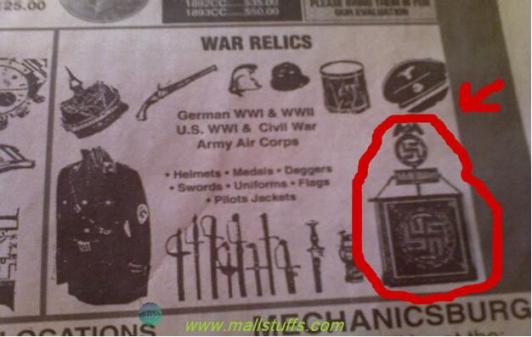
Advertisement of sale of World War II items
Swastika Advertisement of Advertising & marketing Company
Even the advertising and broadcasting service companies used swastika as their brand symbol. This professional company had a big team of agents and marketers who provided branding, advertisement and marketing advices to American companies. Their clients included major American companies of that era. Below is one of such advertisement with the list of client names and the company address.
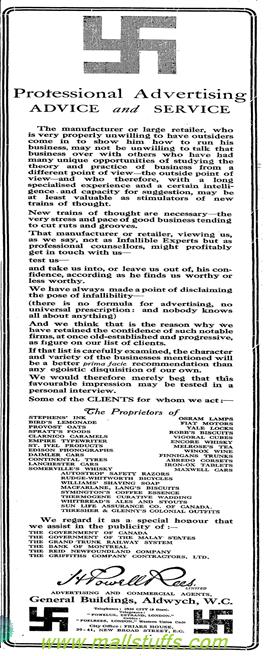
Conclusion:
This article is intended to reclaim the lost significance and importance of humanity earliest symbol ‘Swastika’. Swastika is derived from the Sanskrit word “svastika”- "su" meaning "good," "asti" meaning "to be," and "ka" as a suffix. Swastika signifies the symbol of good luck, prosperity, peace and fortune. After its association with German Nazi party, this ancient symbol has faced a sad transition from a good luck symbol to symbol of evil and adversity. Swastika is still widely used as a good luck symbol in Asian countries like India, China, Japan, Korea, Thailand, Vietnam, Indonesia etc. This symbol has a great spiritual meaning and significance in Hinduism and its derived religions like Buddhism and Jainism.
Ending up with a beautiful swastika from India
